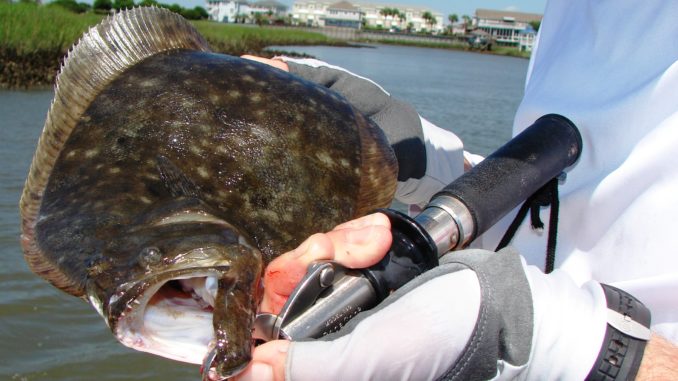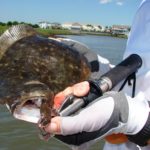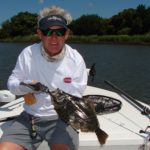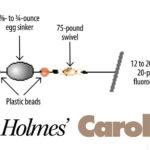
Creeks, waterway, inlets in southern Brunswick County are ground zero for flounder action in steamy weather.
After a short run up the Intracoastal Waterway in lower Brunswick County, Greg Holmes banked his flats boat into one of the many small creeks. Clearing the shoal at the mouth, he chopped the throttle, turned off the outboard and stepped forward to lower the trolling motor. In a couple of minutes, he had the boat positioned and dropped his Cajun Anchor to hold the boat in place.
“I hate to come in here with the outboard running, but the tide is low enough we needed to be on plane to get across that bar at the mouth of the creek,” said Holmes, who runs Fish Skinny Guide Service. “We’ve got an hour or so of fishing here before the falling tide traps us, but this is usually a good spot. I thought we might get a flounder or two and maybe a red or trout, before we have to get out.”
Holmes picked out a medium-light spinning outfit, hooked up a live menhaden and cast up the creek, about 10 feet off the bank, pointing out a submerged oyster bar that might snag the weight and hooks.
“I like to keep the bait moving slowly,” Holmes said. “You need to get the bait pretty close to flounder to get their interest. By slowly retrieving the bait, you cover a lot more bottom and have a better chance of finding one that wants to feed.
“Work your bait all the way back to the boat,” Holmes said. “Don’t get in a hurry and reel it in quickly after only working it a little ways. They might be right below us, too.”
After about 10 minutes, a solid thump resonated up through the rod to one of the fishermen.
“Whoa, hold on just a little,” Holmes said. “That’s a pretty big bait; you need to give him some time to eat it. If you set the hook too quickly, you’ll pull the bait out without hooking him. The flounder needs to turn that bait to swallow it.”
After about 10 seconds, the rod bowed down and stayed bowed. The result of the hookset was a pulsing rod with line cutting through the water. As the fisherman worked it back, it came to the surface, and Holmes could see it was a flounder.
“Don’t lift its head out of the water. If you do, it will shake and try to throw the hook,” said Holmes, who scooped the keeper flounder into the net on its next pass by the boat.
Every 20 minutes, Holmes repositioned the boat closer to the mouth of the creek, knowing the tide would eventually force him to leave. At his last stop, Holmes started casting a Gulp shrimp on a small jighead, mentioning that artificials often produce better than live bait and allow anglers to cover more water more quickly.
Just as he was preparing to move a little, a nice, healthy flounder struck — almost under the boat. The hookset was solid, and after a few minutes, it went into the net.
“That flounder struck hard, didn’t it?” Holmes asked. “It looked like it almost jerked the rod out of your hand. That’s why I tell folks to fish their baits all the way back to the boat. Once flounder get into spots like this, they don’t move much, but they move a little to stay where the current concentrates the bait.”
Holmes spends plenty of time during the peak of the summer concentrating on flounder; their numbers and average size are much better than in the spring, and he can follow them on the falling tide from well back in the creeks almost back into the waterway anywhere between Little River, S.C., and Ocean Isle. In fact, he can fish the end of the falling tide in the creeks and the beginning of the rising tide closer to inlets.
“We’re a ways from the inlet and if the tide has stopped falling here, it should already be rising there,” Holmes said. “We’ll have to move slowly and pick our way through a couple of real shallow places, but I think we can get right behind Tubbs Inlet, and fishing could be good that close to the inlet on this rising tide.”
Even though the tide had been rising near the inlet for a while, there still wasn’t much depth, and Holmes had to maneuver around mud bars and oyster rocks through several creeks to get there from the waterway. The mud bottom turned to sand, but was treacherously shallow on the way to his next spot: a submerged oyster point trailing off from a spot on the bank, disrupting the water flow and disorienting baitfish.
The water was noticeably cleaner, a greenish color. Holmes pointed out current trails pushing along above the oyster rock and said to fish along them to out a few feet on each side. Here, the current was flowing well enough it would sweep the light sinkers and baits across the bottom.
After landing a couple of bait thieves, a small trout and a couple of short flounder, Holmes and his partners landed a nice red drum, then several more flounder. About mid-tide, the water began dirtying up, and Holmes suggested calling it a day.
“We usually catch a few flounder on the rising tide, but they almost always bite better when it is falling and forcing the minnows and shrimp out of the grass and shallow creeks into the larger creeks,” Holmes said. “I headed up the waterway this morning to extend the time we had with the falling tide. It’s usually not this lopsided, but today we caught all our keeper flounder on the falling tide.”
DESTINATION INFORMATION
HOW TO GET THERE — The southern end of Brunswick County pressed against the North Carolina/South Carolina border southwest of Wilmington. The beaches are Ocean Isle and Sunset, with Calabash and Shallotte on the mainland. US 74 provides the easiest access, with NC 130 to Shallotte, NC 179 and NC 904 to Ocean Isle, Sunset Beach and Calabash. Free public boat ramps are at Brick Landing on the mainland across from the east end of Ocean Isle Beach, beside the Ocean Isle bridge on the beach side and beside the Sunset Beach bridge on the mainland side.
WHEN TO GO — Flounder are in the area from late April into December; July and August are a summer peak for numbers, plus the opportunity to add speckled trout and red drum to the catch.
BEST TECHNIQUES — Medium-light spinning tackle is the ticket, including 7-foot rods and 2500 class reels loaded with braid, with a 20-pound fluorocarbon leader. Live mullet minnows, small menhaden and mud minnows fished on Carolina rigs with 12 to 20 inches of leader and hooks in No. 1 to 1/0, matching the size of the bait. Soft plastics retrieved slowly across the bottom on 1/8- to 1/4-ounce jigheads are also productive; they can fished more quickly and cover more water.
FISHING INFO/GUIDES — Greg Holmes, Fish Skinny Charters, 843-241-0594, www.fishskinnycharters.com; Jimmy’s Marine, 910-575-3600, www.jimmysmarsine.com; Sportsman’s Choice Marine, 843-399-9283, www.sportsmanchoicemarine.com. See also Guides and Charters in Classifieds.
ACCOMMODATIONS — Ocean Isle Inn, Ocean Isle, 910-579-0750, www.oceanisleinn.com; Winds Resort Beach Club, Ocean Isle, 910-579-6275, www.thewinds.com; Comfort Inn, Shallotte, 910-754-3044; Days Inn, Shallotte, 910-754-3300; Econo Lodge, Shallotte, 910-755-6444; Brunswick Chamber of Commerce, 800-426-6644, www.brunswickcountychamber.org.
MAPS — Capt. Segull’s Nautical Charts, 888-473-4855, www.captainsegullcharts.com; Sealake Fishing Guides, 800-411-0185, www.thegoodspots.com; GMCO Waterproof Chartbook of North Carolina, 888-420-6277, www.gmcomaps.com.








Be the first to comment